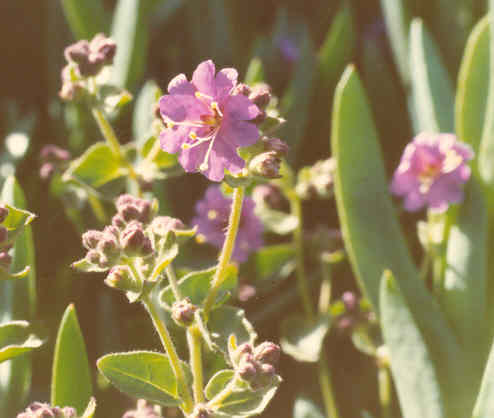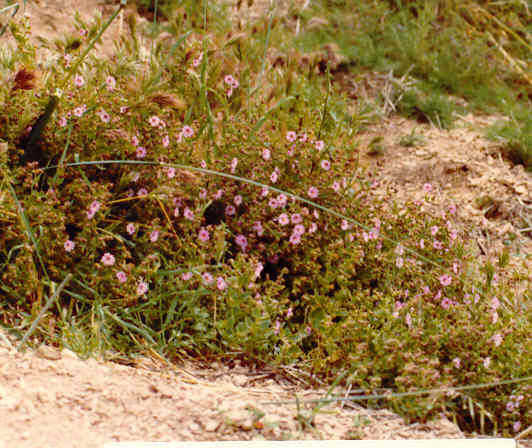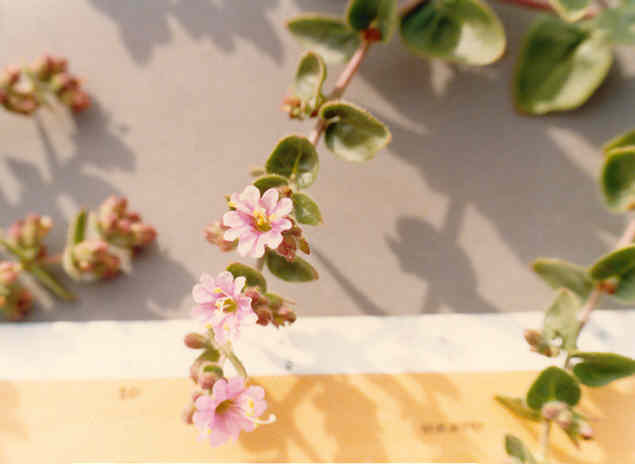
Mirabilis californica A. Gray
=M. laevis
 |
Mirabilis californica A. Gray=M. laevis
Nyctaginaceae (Four O'clock Family)NativeWishbone BushCalifornia Wishbone BushCoastal Four O'clock |
April Photo
Plant Characteristics:
Perennial, somewhat woody at base with many decumbent stems, slender,
subglabrous or commonly viscid-puberulent, repeatedly forked, 1.5-8 dm. long;
petioles 2-15 mm. long; lf. blades ovate, mostly acute, more or less heart
shaped, 1-2.5 cm. long, glabrate to glandular-pubescent; invols. clustered near
ends of branches, short peduncled, bell shaped, 5-8 mm. long, the lobes
subovate, shorter than the tube; perianth rose to purplish-red, 10-14 mm. long;
stamens 5, yellow, petals none; fr. broadly ovoid, lightly dotted or wrinkled,
sometimes smooth, 5 mm. long.
Habitat:
Dry stony washes and on slopes below 2500 ft.; Coastal Sage Scrub;
Chaparral, Foothill Wd.; Monterey Co. to San Diego Co. and to edge of desert.
Channel Ids. Blooms March-May (Dale 139).
Name:
Latin, mirabilis, wonderful.
(Calif. Flora 392).
Californica, the place where the plant was first found.
(Dale 13).
General:
Occasional in the study area. Several
plants have been found on the Castaways bluffs and were photographed there.
In late September 1991, I was amazed to find this plant blooming on the
Castaway's bluffs. It was
surrounded by dry and dead looking Encelia
californica. (my comments).
Wishbone bush is pollinated at night.
The blossoms open about mid-afternoon and do not close until early the
next day, so it is easy to see how Four O'clock, the family name came about.
Wishbone, as a common name for the plant is even easier to understand if
you discover a dead plant. The dry,
forked stems closely resemble the turkey or chicken wishbone we pulled and
wished on as children. (Dale 139).
Delfina Cuero, a Kumeyaay or Southern Diegueno Indian, made the following
comment about Mirabilis californica in her autobiography:
"We used the root, flower and whole plant to make a tea to drink for
stomach ache." (Shipek 94).
The thick tuberous roots of the perennials are poisonous if eaten, and
the seeds of all forms are poisonous. Dermatitis
may result from handling the roots and seeds.
(James 34) About
20 species of warmer parts of America. (Munz,
Flora So. Calif. 583)
Intergrades with M. bigelovii. (Hickman,
Ed. 772).
Text Ref:
Abrams, Vol. II 107; Dale 139; Hickman, Ed. 772; Munz, Calif. Flora 393; Munz, Flora
So. Calif. 584; Roberts 29.
Photo Ref:
Mar 1 83 # 15; April 6 83 # 13; Feb 2 84 # 20,21.
Identity: by R. De Ruff.
First Found: March 1983.
Computer Ref: Plant Data 85.
Have plant specimen.
Last edit 11/15/04.
 |
 |
April Photo February Photo